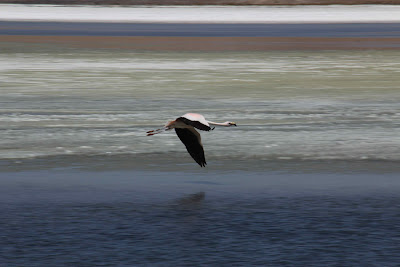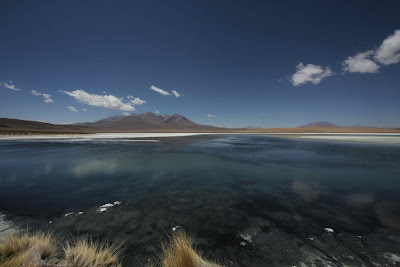 |
| The city of La Paz, in a bowl framed by mountains in all directions |
Bolivia is stunning. Its natural beauty, absolutely vast assortment of varied landscapes and desolation makes it perhaps the most picturesque country we have visited to date. Lamented as South America's poorest country, Bolivia is painted in an unjust light when we consider the true beauty of its countryside.
The change in scenery was almost immediate from the border with Peru. Snow-capped mountains were abundant and it was hard to do anything but stare in awe at the natural attractions out the window.
We had originally thought we might stay in Copacabana (Bolivia), which is on the edge of Lake Titicaca (Bolivia-side). But once we arrived we quickly realised that the attractions were very similar to those of Puno and that we might be better to head on into Bolivia's largest city, La Paz.
 |
| A night at the wrestling - the action often found itself outside the ring and right next to us! |
Our guidebook says that La Paz is breathless - not only because of the snow capped mountains framing the city, nestled in a natural cone of many surrounding mountains, but also because of the continued high altitude (approx 3800m). When we arrived in La Paz we realised that for the last 2 weeks or so we had spent most of our time at an altitude greater than the summit of Mt Cook!

Although La Paz is quick spectacular, the real attractions there are the natural ones, including mountain biking the infamous death road - so named for being the most dangerous road in the world. With Jen decidedly not interested in descending from 4700m to 1200m over 60km of almost continuous downhill, I attempted this brave feat alone (well, actually accompanied with some Australian friends we had met on the bus to La Paz).
 |
| Starjump - awesome!! |
The bike ride was sheer exhilaration. Nothing much wider than a one-lane road separated me from the cliff face on one side and 100m+ drop on the other. It's an absolute mother's nightmare. Hurtling down the road at who know's how fast, placing absolute trust in a bike that you have never ridden before, that has been absolutely punished for every day of its existence and may never have been maintained - WOW - WHAT A THRILL!! Very near the end of the day, I thought it might be awesome to pull a skid in front of my new friends. Accidentally applying the front brake (rather than the rear - I think this might be because the front and rear brakes are the opposite way around from my bike back home), instead of skidding I went superman over the handlebars onto the gravel. Oh the shame. I'd love to say that my bailout on death road was due to a mechanical failure, landslip, some other idiot - but it was nothing but my own fault for trying to do something that didn't need to be done. Fortunately, with knee pads, elbow pads, gloves and a face helmet, no more damage than a sprained wrist was incurred. The biggest damage was a bruised ego!!
Our other La Paz excursion was to the La Cholita wrestling. Not really knowing what we had signed up for, we were treated to a night of WWF style 'staged' wrestling. But with our front row tickets it was a good fun night of 'theatre'.
In La Paz we teemed up with a couple of British girls who were heading the same direction as us. So collectively we caught the bus south to Potosi - the highest town (of its size) in the world at about 4200m. Potosi is known for its mines, which were once used to supply the Spanish with silver used for minting coins, but now are mostly used for the extraction of mostly zinc and tin. The thing to do in Potosi is a mine tour.
After being suited up in coveralls and gumboots (believe it or not there were some that fit me!), we made our way into the mine. Fortunately we went for a tour that didn't involve too much crawling, so for the most part I could walk upright, or only slightly hunched over. The mines are infamous for their poor working conditions and dangerous practices - our guide mentioned that about 70 miners a year are killed in accidents and many more die from the constant inhalation of dust.
 |
| Scary miner dude |
The dust comes from the dynamite explosions that we were lucky enough to experience whilst on our tour. The dynamite (which goes off in sets of 10 or so) sounds like a drum being beaten from two levels and 50 metres away, but the real experience is the feeling you get in your chest. The compression of air feels like it passes straight through you. The sensation is odd and not particularly enjoyable. A few minutes after the explosions the dust comes through the mines. It's so thick you can hardly see more than a couple of metres in front and it clogs your nose, mouth, throat and for many hours afterwards your lungs. I'm glad I did the mining tour, but wouldn't jump at the opportunity to do it again. Jen was pleased she stayed back.

After the night in Potosi we continued south to Uyuni - gateway to the salt flats. The salt flats and surrounding landscape in Bolivia is completely undersold - anywhere else in the world a tour the likes of which we did would be a major tourist attraction pulling 100's if not 1000's of people daily and raking in millions of dollars a year for the country. In our opinion, the salt flat tour is an absolute must for South America and it is only a matter of time before it becomes substantially more popular and crowded. Our tour lasted for 4 days. Together with our new british friends we decided to pay a little extra for a private tour (normally tours are for 6 people), which gave us a little more room to spread out and flexibility to do what we wanted. The sheer variety in landscapes was amazing - starting with the vast salt flats which are almost 200km wide to cross, as flat as a pancake and host a peculiar cactus island in their middle - we continued across lunar landscapes, martian landscapes, lagoons of red, black, blue and green (arsenic), fantastic rock formations, multi-coloured mountains, volcanoes (one of which is active) and above all miles and miles of complete desolation. It's hard to believe just how little there was out there other than the natural beauty of the place.

The days started early and the nights were incredibly cold. The accommodation was basic and the car not especially comfortable, but none of this mattered in the sheer beauty of the place. It's one of the things we would happily do again.
 |
| Jen and our new british friends |
 |
| The many lakes were home to thousands of flamingoes |
 |
| The thin air made for deep blue skies |
 |
| Red lake |
 |
| Thermal activity before sunrise - bloody freezing... |
Satisfactorily tired, we found ourselves near the Bolivian border with Argentina in another picturesque small town, Tupiza. A day off the road to relax and recover before we boarded an incredibly dodgy looking bus, from the age of the dinosaurs and leaning crookedly so much we thought it might tip over - managed to safely take us the last 80km to the border where we said goodbye to Bolivia and hello, for the second time, to Argentina.
 |
| Arsenic-laden green lake |
 |
| Our lunch spot - Day 3 |
 |
| Ruins - end of Day 3 |


 Although La Paz is quick spectacular, the real attractions there are the natural ones, including mountain biking the infamous death road - so named for being the most dangerous road in the world. With Jen decidedly not interested in descending from 4700m to 1200m over 60km of almost continuous downhill, I attempted this brave feat alone (well, actually accompanied with some Australian friends we had met on the bus to La Paz).
Although La Paz is quick spectacular, the real attractions there are the natural ones, including mountain biking the infamous death road - so named for being the most dangerous road in the world. With Jen decidedly not interested in descending from 4700m to 1200m over 60km of almost continuous downhill, I attempted this brave feat alone (well, actually accompanied with some Australian friends we had met on the bus to La Paz). 

 After the night in Potosi we continued south to Uyuni - gateway to the salt flats. The salt flats and surrounding landscape in Bolivia is completely undersold - anywhere else in the world a tour the likes of which we did would be a major tourist attraction pulling 100's if not 1000's of people daily and raking in millions of dollars a year for the country. In our opinion, the salt flat tour is an absolute must for South America and it is only a matter of time before it becomes substantially more popular and crowded. Our tour lasted for 4 days. Together with our new british friends we decided to pay a little extra for a private tour (normally tours are for 6 people), which gave us a little more room to spread out and flexibility to do what we wanted. The sheer variety in landscapes was amazing - starting with the vast salt flats which are almost 200km wide to cross, as flat as a pancake and host a peculiar cactus island in their middle - we continued across lunar landscapes, martian landscapes, lagoons of red, black, blue and green (arsenic), fantastic rock formations, multi-coloured mountains, volcanoes (one of which is active) and above all miles and miles of complete desolation. It's hard to believe just how little there was out there other than the natural beauty of the place.
After the night in Potosi we continued south to Uyuni - gateway to the salt flats. The salt flats and surrounding landscape in Bolivia is completely undersold - anywhere else in the world a tour the likes of which we did would be a major tourist attraction pulling 100's if not 1000's of people daily and raking in millions of dollars a year for the country. In our opinion, the salt flat tour is an absolute must for South America and it is only a matter of time before it becomes substantially more popular and crowded. Our tour lasted for 4 days. Together with our new british friends we decided to pay a little extra for a private tour (normally tours are for 6 people), which gave us a little more room to spread out and flexibility to do what we wanted. The sheer variety in landscapes was amazing - starting with the vast salt flats which are almost 200km wide to cross, as flat as a pancake and host a peculiar cactus island in their middle - we continued across lunar landscapes, martian landscapes, lagoons of red, black, blue and green (arsenic), fantastic rock formations, multi-coloured mountains, volcanoes (one of which is active) and above all miles and miles of complete desolation. It's hard to believe just how little there was out there other than the natural beauty of the place. 

























No comments:
Post a Comment